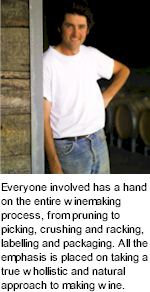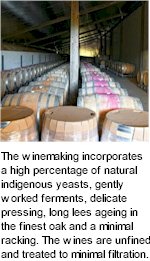


It's all about the environment and care for the land. The Bindi property is situated 50 kilometers northwest of Melbourne in the Macedon Ranges. Originally purchased in the 1950s as part of the larger grazing farm Bundaleer, Bindi is a 170 hectare farm of which 6 hectares are planted to Chardonnay and Pinot Noir. Fifteen hectares are dedicated to managed plantation eucalypts for high grade furniture timber whilst the remainder of the land is maintained as remnant bush land and important indigenous grasslands. The Bindi vineyard is the fundamental focus of endeavors. The vineyard and winemaking philosophy seeks balance and purity in the expression of each individual vineyard site and this philosophy is applied to farming and conservation across the entire property, the preservation of natural harmony.

Vineyard elevation is 500 meters above sea level and soils are predominantly shattered quartz over siltstone clays with some eroded volcanic top soil over clay. Generally unfertile, yields are a scant 1½ to 2 tonnes per acre (3.5 to 5.0 tonnes per hectare). Increasingly low impact, organic outcomes are being trialed and implemented. There are two hectares of Chardonnay, planted in 1988, and four of Pinot Noir, planted in 1988 and 1992. The younger Pinot Noir Block K was established in 2001 and is currently being trained to come of age as a super elite vineyard.
The winemaking incorporates a high percentage of natural indigenous yeasts, gently worked ferments, delicate pressing, long lees ageing in the finest oak and a minimal racking. The wines are unfined and restricted filtration regimes are followed. The yields, harvest date and vinification techniques are deliberately aimed at producing a wine of regional authenticity in a style highlighting fragrance and vitality, harmony and finesse.
The environment, free draining quartzy soils, cool climate and north-facing hill are all reasons the Bindi have done so well. It's the site and environment that produces such exceptional wine. Exclusively French oak barrels are used to make pinot noir, chardonnay and a sparkling wine that is matured in the bottle for up to eight years, a wine high on production cost and relatively low on price, made purely for the fun and indulgence.

Everyone involved has a hand on the entire winemaking process, from pruning to picking, crushing and racking, labelling and packaging. Fastidious small vineyard management regimes are employed, hand pruning, frequent passes, at least ten for each vine, vertical shoot positioned canopies and hand harvesting. Emphasis is on a whollistic and natural approach to making good wine.
The vineyard is the focus but the aim is to maintain balance and harmony between viticulture and wild remnant bush lands. Bindi are unique in that they do not use systemic applications to eradicate pests. Winemaking is an equal partner to preservation of the natural environment. The vines are surrounded by wild grass which has no commercial use. But it's indigenous grass and it's rare, one of the few places in Victoria where it's still intact. It is part of the environment that Bindi aims to preserve. For all of Bindi's 170 hectares, only six are planted to vines. The environmental credentials may have no direct influence on Bindi's critical acclaim, which is judged purely on wine. But it is one of the reasons for the estate's success. The vines exist in a natural, harmonious environment, and that is why the vineyard is viable in the long term.
The quartz riddled, gently north sloping three acre Original Vineyard produces very fine, spicy, fragrant wine that has high natural acidity and develops beautifully. Block Five is a half hectare on a sheltered, north facing, and very quartz riddled site. It is a wonderful natural vineyard exposition. Pinot Noir from here is always darker in fruit expression and immediately more spicy and earthy than the Original Vineyard. It is less immediately perfumed and has more tannin and fruit power. At the upper end of the Chardonnay plantings, where the quartz incidence in the soil is the greatest, the fruit has extra complexity, finesse and intensity. A half hectare site, exceptional wine comes from this soil.
